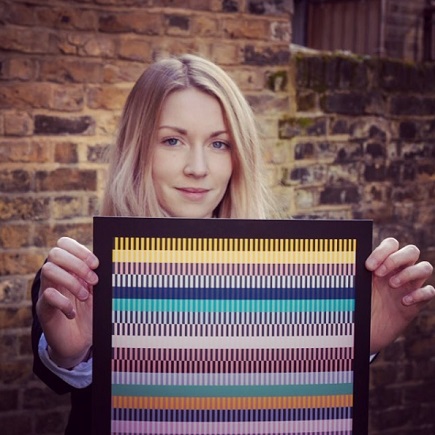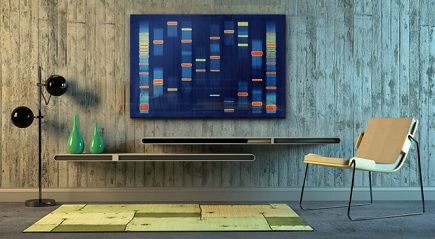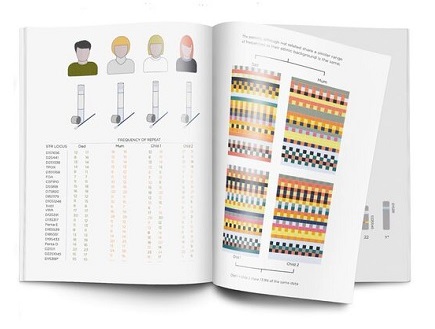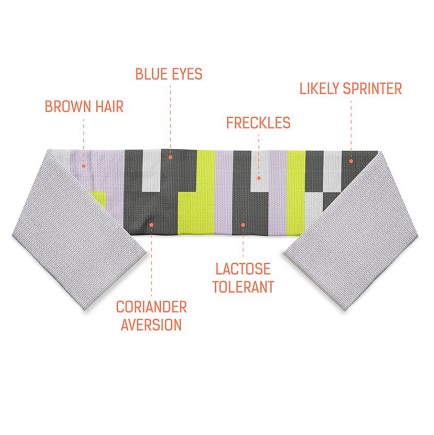
This company creates stunning unique gifts from DNA
Have you ever wondered what your DNA would look like up close? You might picture the classic helix structure, or maybe lots of complex looking molecules. DNA art provides the opportunity to visualize your DNA in a more interesting way, with different colors and materials giving you a variety of formats on which to display it. Whether you’re looking for unique home décor for yourself or personalized gifts for those people that seem to have everything, these DNA pictures provide striking and original artwork that is totally unique.
All you need to provide for this artwork to be designed is a saliva sample, which you can take in minutes at home. This is sent to a specialist laboratory for analysis which designers and artists use to visualize the results in a variety of ways, using a range of colors, patterns, and materials.
Dot One, founded by Royal College of Art graduate Iona Inglesby, is just one of many companies that create DNA art. But whilst most others focus on presenting your DNA profile as the classic ‘barcode’ style image, Dot One approaches it slightly differently. With a broader aim of bringing a better understanding of genetics to its customers, providing an innovative way in which to explore your identity, Dot One looks set to redefine the way we look at our DNA.
If you’re interested in turning your DNA into artwork or buying someone a unique gift, take a look at the different types available via our DNA art listings page.
How does it work?

A piece of DNA art that uses the barcode image.
The process of creating DNA art usually involves three main stages. Providers first purify the DNA that’s extracted from a saliva or cheek swab sample, collected using a kit sent to your home. Once the samples reach the lab, the DNA is treated with a solution that cuts it into lots of smaller strands of DNA, each containing one or a few genes. Those that are going to be used to create your DNA art are then amplified, meaning that lots of copies are made, using a process called PCR. Once there are enough copies, a specialized gel is used to separate the resulting strands of DNA.
This gel can be photographed to provide DNA images that can be customized using a range of materials as the base, ranging from gallery-quality canvases to metal or glass. They can also be colored to suit wherever you want your image to hang. Many providers will also offer a digital copy of your DNA art, giving you the chance to share your masterpiece with everyone you know!
What makes Dot One different?
It’s immediately obvious from the Dot One website that this company offers customers more than just a DNA test. Rather than displaying DNA images of gels, as many other companies do, Dot One analyses the unique patterns present in your DNA to design a wide range of high-quality, bespoke products. Using a unique algorithm, the company designs custom art prints, wearable products, such as scarves, and even handwoven rugs, using just the fraction of your DNA that defines you from others. Much more than gimmicky gifts, these products beautifully express how well the two seemingly opposing disciplines of science and art can perfectly complement each other.
The way in which your DNA is displayed isn’t all that’s different about Dot One. Something else that stands out about this company is how its products reflect the idea of expressing identity through design. One example of this is in its DNA Family Tree. Several companies that sell DNA art enable you to incorporate the DNA of different family members, but once again Dot One goes a bit further than most.

The booklet that accompanies each Dot One test kit.
Bright colors and simple yet striking patterns make it easy to see exactly which parts of DNA have been passed from one generation to the next, intertwining the DNA of each family member in a way that draws you in and encourages you to explore.
Not just this product, but also almost every part of the business, exemplifies the ideas that indicate Dot One wants to be more than just a DNA testing provider. Each piece of custom art is designed to enthuse and motivate people to explore their DNA, in a way that’s informative and imaginative all at once. To many, DNA is somewhat intimidating or even irrelevant, associated with science fiction or confined to the medical world. With a Dot One product, you are not only provided with thoughtful, personalized gifts for others or yourself, but are invited on a collective journey towards a better understanding of and a greater familiarity with DNA testing.
This is further demonstrated in the booklet that accompanies each product. It explains more about DNA, genetic testing in general, and how the process of turning your DNA into art works, using original illustrations and diagrams. The feeling that you’re reading a story rather than an instructive manual adds to the sense that DNA can be something which we all might one day consider part of our daily lives.
The designer behind Dot One

The Japanese ribbons that inspired Iona.
None of these features have come about by accident. They are the result of the decisions made by Dot One’s founder, Iona Inglesby, who describes herself as having almost fallen into setting up the business in 2015. This seems hard to believe when you consider the attention to detail evident in every part of the company and the speed at which it has grown.
The ideas behind the company started as part of a university project, when she was studying towards her MA in Design Products at the Royal College of Art in London. This assignment took her to a weaving company in Scotland, where she was intrigued, but a bit disappointed, to find that anyone could assign a tartan pattern to their family name. This was in contrast to what she later found in ribbons used for Japanese swords which have a special significance, and which inspired her to design the patterns now used in many of the Dot One products.
Although always having had an interest in science and technology, Iona was first inspired to incorporate them into her designs after taking a short synthetic biology course alongside her other studies. This led to the incorporation of DNA into her university project, which eventually evolved into Dot One. Everything was designed by Iona herself, from the website to the booklet that accompanies each of the kits.
How Dot One’s DNA art is made

The DNA Knit scarf.
Dot One’s products are made in collaboration with the UK based company NorthGene, who have an established reputation for familial relationship testing. When you purchase a product with Dot One, you’ll be sent a kit, which you’ll return to their lab once you’ve taken your saliva sample. They’ll analyze your sample to identify short tandem repeats (STRs) at certain points in your DNA, which is also the standard procedure used for familial relationship tests. These STRs are patterns of 2-5 letters in the code of your DNA that are repeated several times. Although the patterns themselves are the same and are found at the same points in the DNA sequence of different individuals, the number of times that they are repeated differs. These differences are part of the reason that none of us are the same, and why Dot One’s products make truly unique gifts for whoever receives them.
Once these STRs are sent back to Dot One, they are transformed into whichever type of DNA art you ordered. Each step of this process is described and explained in the illustrated booklet that accompanies every test kit, designed by Iona herself.
23andMe collaboration
More recently, Dot One has also offered 23andMe customers the option to upload their data rather than having to provide another DNA sample. The 23andMe data is made up of single nucleotide polymorphisms or SNPs, rather than STRs. These are slightly different and many more of them are identified in each test, but they are similar in the fact that they are one of the reasons for genetic variation between individuals.
As there are thousands more SNPs in a 23andMe data file than STRs in a test taken with NorthGene, a few had to be selected to use to make Dot One’s products. After consideration, the SNPs associated with 33 different traits were selected as the blueprint with which to translate your 23andMe genetic data into a DNA Knit scarf or DNA Cushion Knit.
Dot One’s products
Speaking to Iona, it’s clear that the products are popular as personalized gifts, but also appeal to those wanting to treat themselves to some unique home décor or accessories. One of the first products offered on the website, and still one of the most commonly purchased, is the DNA Personalised Print.

The DNA Personalised Rug.
This is one of the more affordable products you can buy from Dot One, and provides you with an A2 design, representing your personal genetic markers. A list of these markers accompanies the DNA pattern ensuring that as well as making great unique gifts, these prints provide excellent starting points from which to explore your DNA.
For those that want to go a step further than simply displaying their DNA as an image, Dot One offers the chance to wear it with style. As well as the DNA Knit that’s based on 23andMe data, the company offers a DNA Personalised Scarf. Hand woven and made from lambswool, these scarves not only make truly unique gifts, but add an extra level of luxury to your wardrobe.
Iona’s own ideas and experiences are reflected in many of the products, but most clearly in the DNA Tartan, which uses genetics to add real identity to the design, in a way that wasn’t the case for the traditional ones she’d encountered during her studies. With the option to include two DNA samples, these 200 × 120cm pieces of hand-woven lambswool make ideal personalized gifts for those just starting or expanding their family.
The product on our personal wish list is the ultimate piece of unique home décor – the DNA Personalised Rug. This is yet again hand woven with wool and features similar patterns to the scarves and prints. The rugs themselves are made by award winning British weaver, Angie Parker, and come with a free DNA print.
The future of Dot One
So, what next for Dot One? One current obstacle for company and customer alike is the price. I would argue that despite the relatively high cost, the products still offer value for money, considering the quality of the materials and manufacturing techniques. However, there is no denying that for many the majority of the products are not affordable. Luckily, and perhaps unsurprisingly, a big focus for the company going forward is to find ways in which to reduce the cost, whilst maintaining the care and quality that has come to define its products.
Iona hopes to be able to relaunch the site sometime during summer, to go some way towards achieving her ultimate vision for the company – to have physical high street stores, selling a wide range of products. To do this, she is going to need to attract a wider audience that includes younger, less affluent customers.
Something that might surprise you is that a significant proportion of Dot One’s customers are male. Many of the products are bought as personalized gifts, but not all of the men buying these items are purchasing them for someone else. This is something that Iona intends to respond to, with plans to develop more male-orientated accessories. She’s keen to create items that allow men to explore and express their identity in everyday life, with items, such as socks, ties, or men’s scarves, that add a bit of color and personality to a workday suit, for example.
This isn’t to say that she’s focusing solely on men’s products. Iona also hopes to expand the range of women’s accessories offered by Dot One, at a more affordable price. She hopes to continue to build their appeal as unique gifts, whilst making products that a greater number of customers can also treat themselves to.
As someone doing something distinct in a quickly developing market, I was intrigued to find out what Iona thought the future might hold, not just for Dot One, but for the consumer genetics market as a whole. Whilst acknowledging that privacy is an issue that both companies and customers should remain vigilant about, she envisions a day, in the not too distant future, where we will all have a copy of our genetic data that we consider and use as part of our everyday lives. With companies like Dot One leading the way, this seems likely to become a reality.
